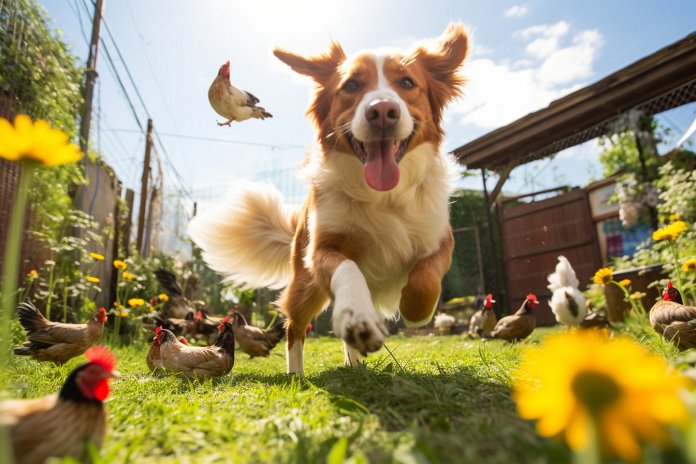
Are you thinking about getting a chicken as a pet but are unsure how your dog will react? While it is possible for dogs and chickens to live together, there are some considerations to keep in mind. In most households, dogs are higher up on the food chain than chickens, so it may take some patience and determination to make them get along. The success of their relationship depends on the breed of dog and the amount of supervision you can provide.
Signs Your Dog Isn’t Getting Along with Your Chicken
Dogs have natural predatory instincts, so it’s important to observe your dog’s behavior around chickens. If your dog shows disinterest or curiosity without predatory responses, training may be possible. However, if your dog exhibits predatory behaviors or shows little to no warning before attacking, it may be best to keep them separated.
Body Language
Some signs of predatory behavior in dogs include growling, staring, barking, freezing, tense jaw, raised back hair, stalking, ears up, exposed teeth, and a stiff tail. Other signs to watch for are unbreakable focus, chasing the chicken, crouching near the pens, and hyper behavior around the bird.
The History of Dogs Living with Chickens
Before domestication, dogs were natural predators, and birds fell below them on the food chain. While domesticated dogs have evolved to be more companionable, they still possess a prey drive to some extent. Certain dog breeds used for hunting may not be compatible with small animals, but more passive companion breeds may be less aggressive.
The Science Behind Dogs Living with Chickens
A dog’s prey drive is influenced by factors such as breed, experience, opportunity, motivation, and social facilitation. While domesticated dogs are less equipped for hunting, their prey drive is still preserved. Once predatory behavior is recognized, steps can be taken to prevent any accidents.
Training a Dog to Live with Chickens
Introducing dogs and chickens should be done slowly and carefully. Start with minimal exposure and gradually increase contact. Always watch your dog’s body language during the process. Use a neutral area for introductions, keep your dog leashed and your chicken caged, reward good behavior with treats, and never leave them unsupervised.
Conclusion
With proper introductions and training, dogs and chickens can potentially live together peacefully. However, it is important to always prioritize safety and be aware of your dog’s behavior. By taking the necessary precautions and providing proper supervision, you can create a harmonious living environment for both your dog and chicken.
“Building a bond: Training your dog to live harmoniously with chickens.”

Tips & Things to Know
1️⃣ Understand your dog’s behavior: It’s important to observe your dog’s behavior and determine if they show predatory responses or can be easily distracted from the chicken. This will help you assess whether training is possible or if further precautions need to be taken.
2️⃣ Start introductions slowly: When introducing your dog and chicken, start with the least amount of exposure and gradually increase their interaction. Use a neutral area and keep your dog leashed and your bird caged during the initial introductions. Reward both pets for good behavior to encourage a friendly relationship.
3️⃣ Never leave them unsupervised: Even after several introductions, it’s crucial to never leave your dog and chicken together unsupervised. Predatory behavior can still occur, so it’s important to continue observing your dog’s behavior and providing them with plenty of attention and exercise throughout the day.
Frequently Asked Questions, Answered ✅
1. Can dogs and chickens live together in the same household?
– Yes, it is possible for dogs and chickens to live together, but it may require patience and supervision.
2. What are some signs that my dog may not get along with a chicken?
– Signs include predatory behaviors such as growling, staring, barking, and chasing the chicken.
3. Are all dog breeds compatible with chickens?
– Some dog breeds, particularly those used for hunting, may not be compatible with smaller animals like chickens. Companion breeds may be more compatible.
4. What factors contribute to a dog’s prey drive?
– Breed, experience, opportunity, motivation, and social facilitation all contribute to a dog’s prey drive.
5. How can I train my dog to live peacefully with chickens?
– Start with slow introductions, use a neutral area, keep your dog leashed and the chicken caged during introductions, reward good behavior, and never leave them together unsupervised.